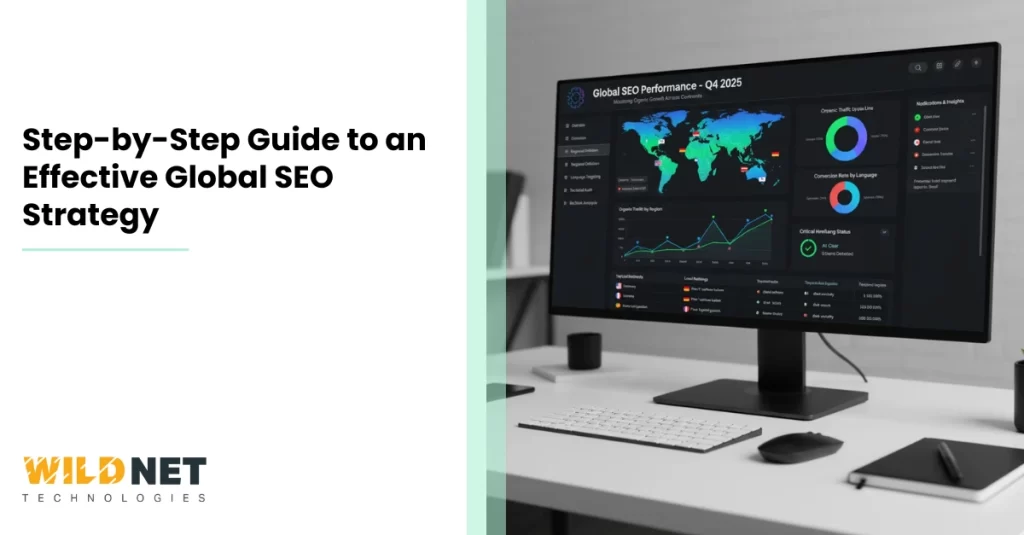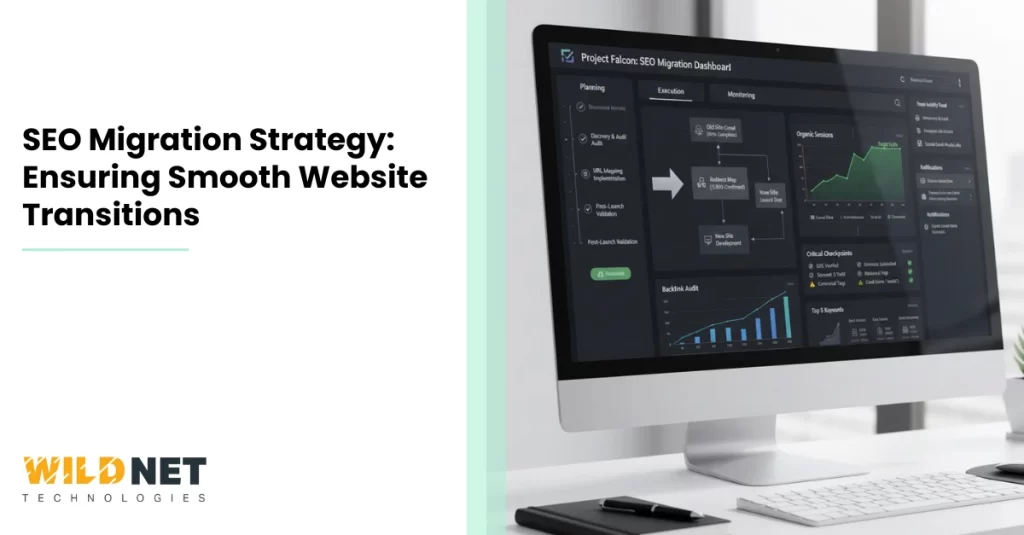In today’s digital age, reaching a global audience is crucial for business growth. A well-crafted global SEO strategy can make this possible and help businesses connect with diverse markets and cultures.
Understanding the nuances of international SEO is key. It involves more than just translating content. You must consider cultural differences and local search behaviors.
A global SEO strategy requires thorough research. Identifying the right keywords for each market is essential, as this ensures that your content resonates with local audiences.
Technical SEO plays a vital role in international reach. Optimizing site speed and mobile-friendliness is crucial. These factors impact user experience and search rankings.
Localization is another critical aspect. Tailoring content to fit local languages and customs enhances engagement. It builds trust with your audience.
Integrating global SEO with digital marketing efforts amplifies results. It creates a cohesive strategy that drives traffic and conversions. This approach supports long-term business success.
Crafting an effective global SEO strategy is a complex but rewarding endeavor. It requires continuous learning and adaptation. With the right approach, businesses can thrive in the international market.
Understanding Global SEO: Key Concepts and Differences
Global SEO differs significantly from local SEO. It targets multiple countries and languages. This expansion introduces unique challenges and opportunities.
Understanding cultural nuances is critical. Different regions have distinct search preferences, and adapting to these preferences boosts your global presence.
Here are key concepts to consider in global SEO:
- Localization: Adapting content to reflect local culture and language.
- Hreflang Tags: Signaling language and regional targeting to search engines.
- Multilingual Content: Creating content in various languages for a broader reach.
Incorporating these concepts requires careful planning. You must align them with your business goals. This approach ensures consistency and effectiveness.
Moreover, technical optimization should not be overlooked. Each market may have distinct technical requirements, and addressing these is crucial for seamless site performance.
Global SEO is an ongoing effort. It requires continuous analysis and updates. Staying informed about global digital marketing trends is essential.
Gleaning these key concepts can help you develop a robust global SEO strategy. This understanding sets a strong foundation for your international efforts and paves the way for effective engagement with global audiences.
Why a Global SEO Strategy Matters for Digital Growth
A global SEO strategy is crucial for expanding digital reach. It allows businesses to tap into new markets and audiences. This expansion drives significant opportunities for growth.
Ignoring a global strategy limits potential. International SEO helps companies connect with diverse audiences. These connections are invaluable for building brand recognition.
Adopting a global approach brings unique advantages:
- Broader Audience Reach: Access more potential customers worldwide.
- Increased Brand Visibility: Enhance recognition in different markets.
- Improved ROI: Optimize spending for better returns on investment.
Digital growth hinges on reaching new customers. Understanding their behaviors and preferences is essential. A well-crafted strategy ensures tailored engagement.
Ultimately, global SEO can transform a brand’s digital footprint. Embracing it can lead to greater brand success. Companies that leverage international SEO position themselves as leaders in their industries.
Analyzing International Markets and Audience Behavior
Understanding international markets is the foundation of effective global SEO. Each market has unique characteristics that require careful analysis. This understanding ensures that strategies meet specific audience needs.
Researching audience behavior helps identify what resonates with potential customers. Cultural norms and purchasing habits vary widely, so tailoring content and marketing strategies to these nuances is crucial for success.
Key steps in analyzing markets include:
- Market Research: Identify potential customer demographics and preferences.
- Cultural Insights: Understand local customs that might influence consumer behavior.
- Competitor Analysis: Recognize what local competitors are doing well.
Audience behavior encompasses more than just searches. It reflects how people interact online, from social media to shopping habits. Observing these patterns informs the creation of relevant, engaging content.
Finally, maintaining flexibility is vital. Market conditions and consumer preferences can shift rapidly. Regular analysis helps adjust strategies, ensuring continued alignment with audience needs, maximizing international SEO impact, and fostering sustainable growth.
International Keyword Research: Finding the Right Terms
Conducting international keyword research is a pivotal aspect of global SEO. Keywords vary by language, region, and cultural context. Selecting appropriate terms ensures visibility in local search results.
Begin by understanding the local language intricacies. Translating keywords is not enough. Accurate translations must also consider cultural relevance and vernacular expressions. This ensures keywords resonate with the target audience.
Utilize specialized keyword research tools for global markets. These tools provide insights into search volumes and competition levels. Opt for tools that offer localized options, enhancing accuracy.
Consider the following steps for effective international keyword research:
- Localize Keywords: Adapt terms to fit cultural nuances.
- Use Local Tools: Employ region-specific tools for precise data.
- Analyze Competitors: Observe and learn from local market leaders.
Understanding local intent behind searches is crucial. This means knowing why users in one country search differently. For instance, product names might vary despite being similar products.
Incorporating local context into keyword strategy ensures alignment with user needs, leading to higher engagement and conversion rates. Lastly, constant monitoring of keyword performance and adjusting strategy is vital. This helps capture emerging trends and maintain relevance in dynamic markets.
Content SEO Strategy for Global Audiences
Crafting a content SEO strategy that speaks to a global audience involves more than just translation. It requires a deep understanding of diverse cultural contexts, and each audience segment has unique needs and preferences.
Start by identifying the right content for each market. This involves customizing messages while maintaining brand consistency. Tailored content increases engagement and builds trust with local audiences.
Utilize the following practices to enhance global content strategy:
- Cultural Sensitivity: Respect local traditions and customs.
- Localized Content: Adapt themes and narratives for local relevance.
- Consistent Branding: Maintain a uniform brand voice globally.
Cultural sensitivity is crucial for success. Local idioms and beliefs should inform content creation. Ignoring these elements can lead to misunderstandings and lost opportunities.
Leverage local talent to create authentic content. Local writers, designers, and marketers understand regional nuances and can produce more genuine material. This helps connect with audiences on a deeper level.
Lastly, invest in tools that facilitate multilingual content management. These tools can streamline content creation and ensure consistency across languages. This investment pays off by enhancing user experience and search engine rankings.
Technical SEO for International Reach
Achieving international reach hinges on effective technical SEO. This involves optimizing your website’s backend to ensure search engines can index it correctly. A seamless user experience across borders starts with robust technical foundations.
Site speed is critical. Fast-loading pages enhance user retention and improve search rankings. Regularly test your site’s performance and implement improvements to keep load times under control.
Mobile-friendliness is non-negotiable. Many users access content via their smartphones. A responsive website design ensures that international users can navigate your site easily, regardless of device or screen size.
Technical SEO elements to prioritize:
- Site Speed: Optimize images and scripts.
- Mobile Optimization: Implement responsive design.
- Security: Use HTTPS to secure your connection.
Security, especially HTTPS, is crucial for building trust with a global audience. It ensures data privacy and protects user information, fostering confidence in your site.
Lastly, pay attention to structured data markup. This helps search engines understand your content better. Rich snippets can enhance search results, attracting more international visitors. With these elements, your site can excel in a competitive global market.
Website Structure, Localization, and Hreflang Implementation
A well-structured website is a cornerstone for global SEO success. It helps both users and search engines navigate efficiently. Your international audience should find it easy to locate information, regardless of language or location.
Effective localization goes beyond simple translation. Adapt your content to resonate with local customs and cultural nuances, making your site more relevant and engaging for international users.
Implementing hreflang tags is crucial for targeting multiple languages and regions. These tags tell search engines which version of your content to serve in different locales. This prevents duplicate content issues and ensures the right audience sees the correct version.
Key aspects of international website optimization include:
- Clear Navigation: Easy-to-use menus and structure.
- Localization: Tailor content for cultural differences.
- Hreflang Tags: Indicate language and regional intent.
Ensure straightforward navigation. Use intuitive menus and categories to enhance user experience. This encourages visitors to stay longer, reducing bounce rates and boosting engagement.
By aligning these elements, your website can reach and appeal to diverse audiences globally. These practices also enhance visibility in international search results, supporting your global SEO strategy.
Building Local Authority: Backlinks and Partnerships
Establishing local authority is crucial for boosting global SEO performance. Building quality backlinks is an effective way to achieve this. Backlinks from local sites enhance credibility and improve search engine rankings.
Partnering with local businesses can help earn these valuable links. Collaborations enable you to leverage each other’s audiences and build community ties. For example, guest posting on local blogs offers mutual benefits.
Focus on creating partnerships that add value to both parties. Genuine relationships based on shared interests or goals are more fruitful. Engaging with local influencers is another strategy to expand reach and authority.
Essential strategies for building local authority include:
- Quality Backlinks: Seek local site endorsements.
- Community Partnerships: Collaborate with regional businesses.
- Influencer Engagement: Leverage local voices.
Building local authority takes time and effort. However, the payoff includes better search rankings and enhanced brand visibility in targeted regions. Prioritizing genuine connections supports sustained international SEO success.
Integrating Global SEO with Digital Marketing Channels
A cohesive global SEO strategy works best when integrated with other digital marketing channels. By doing so, you can create a unified brand message across platforms. This integration ensures that all digital efforts support and amplify each other.
As part of your global SEO strategy, social media can drive significant traffic. By sharing optimized content on social platforms, you enhance visibility and engagement. Social signals also boost your SEO efforts by increasing brand awareness.
Email marketing is another channel that complements global SEO. Personalized emails can re-engage users and drive them back to your site, supporting SEO goals. Ensuring that email campaigns link back to SEO-optimized pages is key.
Key methods to integrate SEO with digital marketing:
- Social Media: Amplify content reach.
- Email Marketing: Enhance re-engagement.
- Consistent Branding: Align across channels.
Overall, seamlessly integrating SEO and digital marketing channels maximizes your reach. It enhances your international presence and drives coherent results across all markets. Collaborating cross-functionally ensures these strategies align and reinforce one another effectively.
SEO Strategy for E-commerce Websites Expanding Globally
E-commerce businesses looking to expand globally face unique SEO challenges. First, understanding your target markets is crucial. Knowing regional preferences and shopping behaviors can effectively shape your strategy.
Selecting the right keywords for international audiences is vital in this process. When conducting keyword research, consider the nuances of language and culture. This approach ensures that content resonates with local consumers in diverse markets.
Localizing product descriptions and categories improves search engine visibility. This customization enhances user experience, leading to higher conversion rates. Localization also involves adapting currency, units, and payment methods according to local standards.
To boost your global e-commerce SEO strategy:
- Localized Keywords: Capture regional interest.
- Cultural Adaptation: Tailor user engagement.
- Payment Flexibility: Increase accessibility.
Optimizing site speed and mobile-friendliness is essential. Fast, responsive sites improve user satisfaction and rankings across all regions. A strategic global SEO approach can significantly enhance an e-commerce website’s international presence.
Measuring Success: Analytics, KPIs, and Continuous Improvement
Tracking the success of a global SEO strategy requires robust analytics. Key Performance Indicators (KPIs) serve as essential benchmarks. They provide insights into the strategy’s effectiveness across various regions.
Focus on KPIs tailored to your global goals. These include organic traffic growth, conversion, and bounce rates from different countries. Regularly monitor these metrics to gauge progress over time.
Continuous improvement relies on data-driven insights. Analyzing this data helps identify trends and areas for enhancement. It also highlights what aspects of the strategy are performing well in specific markets.
To refine your global SEO strategy:
- Traffic Analysis: Understand visitor behavior.
- Conversion Tracking: Measure goal completions.
- Regular Audits: Identify growth opportunities.
Emphasizing a culture of evaluation and adaptation is crucial. This approach ensures your strategy remains effective amid the ever-changing digital landscape.
Common Challenges and How to Overcome Them
Implementing a global SEO strategy presents unique challenges. Language barriers, cultural differences, and technical issues often arise. Addressing these challenges head-on is essential for success.
Language differences can lead to misunderstandings. Using native speakers for translations ensures content resonates with local audiences, helping maintain the intended message without losing meaning.
Technical hurdles, like managing hreflang tags or dealing with site speed, require careful planning. Ensuring your website structure supports multiple languages and regions is vital. Regular technical audits can help identify and resolve issues early.
To tackle common international SEO challenges:
- Use Localization: Adapt content for cultural nuances.
- Monitor Algorithms: Stay updated on changes.
- Seek Local Expertise: Collaborate with regional experts.
Conclusion: Building a Scalable and Adaptable Global SEO Strategy
A successful global SEO strategy demands scalability and adaptability. Your approach must adjust as markets evolve to meet new challenges and opportunities. Flexibility is key to effectively navigating these changes.
Fostering a comprehensive understanding of different cultures and languages enhances audience engagement. Tailor your strategy to respect local preferences and varying search behaviors. This approach ensures your brand resonates globally.
Regular analysis and adjustment keep your strategy aligned with the latest trends. Continuous monitoring helps refine tactics, making your global presence stronger and more resilient.
Implementing strategies allows businesses to uncover new growth opportunities and maintain a competitive edge in today’s digital landscape. Our expert team is ready to assist if you want to elevate your online presence. As a trusted SEO services and digital marketing company, we deliver measurable results, boost search rankings, and maximize ROI—partner with us to enhance your visibility and turn search traffic into sustainable business success.
1. What is Global SEO?
Global SEO is optimizing your website for multiple countries and languages to attract traffic and customers worldwide.
2. How is Global SEO different from International SEO?
While both focus on targeting audiences outside your home country, Global SEO typically covers broader worldwide strategies, whereas International SEO often targets specific countries or regions.
3. Why is Global SEO important for businesses?
It helps companies expand their digital footprint, build brand awareness worldwide, and connect with diverse customer bases across multiple markets.
4. What are the key elements of a successful Global SEO strategy?
Language optimization, hreflang tags, geo-targeting, cultural relevance in content, and region-specific keyword research are essential.
5. Should businesses partner with an SEO agency for Global SEO?
Yes, because Global SEO requires expertise in technical optimization, multilingual content, and cross-border digital marketing strategies that professionals best handle.
Read More
- Google AI Overviews: How They Work and Why SEO Needs a New Strategy
- What Is The Digital Marketing Strategy That Tracks Users Across The Web?
- How Can Email Marketing Fuel Your Overall Inbound Strategy?
- What Is PR in SEO and Why Does It Matter for Your Digital Marketing Strategy
- Why Zudio Marketing Strategy is Taking Over the Apparel Industry?






